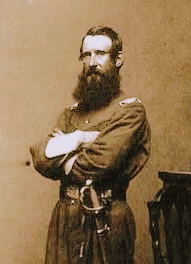Boston Irish Civil War Leader Thomas Cass , Born June 4, 1821 in Ireland

Colonel Thomas Cass Statue, Boston Public Garden
Boston Civil War hero Thomas Cass, commander of the Massachusetts Ninth Regiment, was born on June 4, 1821 in Farmleigh, Queen's County (now County Laois).
His family immigrated to Boston when he was an infant, and settled in the North End, at that time a heavily Irish neighborhood. Cass was a member of the Boston School Committee and a successful businessman. During the 1850s, he organized a local militia unit of Irish immigrants known as the Columbian Artillery but the group was dismantled by the nativist Know-Nothing movement in 1855.
When the Civil War broke out, and with the encouragement of Governor John Andrew, Cass gathered his men to form Boston's first Irish troop, the Ninth Regiment. Colonel Cass reported with the regiment of 1,022 men at the State House on Tuesday, June 25, 1861, to receive the state flag and to be reviewed by Governor Andrew.
Fellow Irish immigrant Patrick S. Gilmore and his Band played at the ceremony and a large crowd gathered to see them off. According to the Pittsfield Sun, "The 9th Massachusetts Regiment sailed from Boston for Fortress Monroe (and) took 70 horses, 21 baggage wagons, and full equipments, including 20,000 rounds of ball cartridges."
The Ninth Regiment fought gallantly in its first year before Colonel Cass was wounded at the Battle of Malvern Hill, Virginia, on July 1, 1862. He was taken back to Boston via New York and Fall River, accompanied by his wife and son, according to the Barre Gazette, which also noted, "He was most shockingly wounded in the head while rallying another regiment to his own."
Cass died on July 12 and was buried with military honors at Mt. Auburn Cemetery in Cambridge. The Regiment continued to fight under the leadership of Patrick R. Guiney, a Tipperary native who came to Massachusetts in 1842. The 9th Regiment finally made it home on June 15, 1864, where it was met by friends and loved ones and were paraded through the city.
Citizens of Boston placed a granite memorial to Thomas Cass at Boston Public Garden in 1889, but it was deemed artistically inferior and insufficient to adequately honor the memory of Colonel Cass. A replacement bronze memorial, created by artist Richard Edwin Brooks, was unveiled in 1899 beforeMayor Josiah Quincy and other leading citizens attending the dedication. The memorial gained gold medals for the artist at the Paris Exposition in 1900 and the Buffalo Exposition in 1901.
Mount Auburn Cemetery, Cambridge
In 1943 the Ninth Regiment Veterans' Association placed a new memorial stone at the grave of Thomas Cass at Mt. Auburn Cemetery in Cambridge. The new stone was approved by Boston City Council on the recommendation of Mayor Maurice Tobin.
The 9th Regiment flag, along with other flags from Civil War regiments, is now part of the Hall of Flags at the Massachusetts State House.
The Friends of the Public Garden has an innovative program to light up many of the statues in the Public Garden and Commonwealth Avenue Mall. For more information on Boston's historic parks and open spaces, visit Boston Parks and Recreation Department.
The Thomas Cass statue in the Public Garden is part of Boston's Irish Heritage Trail.
Research + Text, Michael Quinlin






Comments
Post a Comment